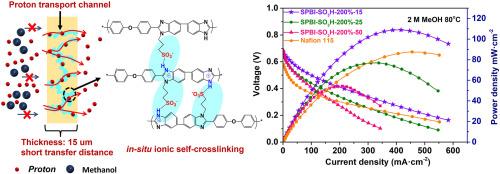Methanol tolerable ultrathin proton exchange membrane fabricated via in-situ ionic self-crosslinking strategy for high-performance DMFCs
IF 8.4
1区 工程技术
Q1 ENGINEERING, CHEMICAL
引用次数: 0
Abstract
Proton exchange membranes (PEMs) with high proton conductivity, mechanical stability, and methanol barrier capability is urgently needed for direct methanol fuel cell (DMFCs). In response, a series of highly sulfonated polybenzimidazoles (SPBI) were synthesized, followed by the creation of a unique in-situ ionic self-crosslinking mechanism via acid-base pair interactions between –SO3- and protonated N within the imidazolium rings of SPBI in an acidic milieu. The in-situ ionic self-crosslinking not only significantly enhances the mechanical stability of the prepared membrane, but also constructs a microstructure with a free volume radius smaller than the molecular dimensions of methanol, subsequently imparting unparalleled resistance to methanol permeation. After being reduced to an ultrathin thickness of 15 μm, the optimal SPBI-SO3H-200 % membrane obtains remarkable high specific proton conductivity of 33.48 S cm−2. Furthermore, the assembled DMFC demonstrates an exceptionally low methanol crossover current density of 188.25 mA/cm2 alongside high power density of 109.92 mW cm−2 within 2 M methanol fuel, significantly outperforming the methanol crossover current density of 386.06 mA/cm2 and power density of 87.13 mW cm−2 achieved by a single cell assembled with Nafion 115 membrane.

通过原位离子自交联策略为高性能 DMFC 制作耐甲醇的超薄质子交换膜
直接甲醇燃料电池(DMFC)迫切需要具有高质子传导性、机械稳定性和甲醇阻隔能力的质子交换膜(PEM)。为此,我们合成了一系列高度磺化的聚苯并咪唑(SPBI),然后在酸性环境中通过 SPBI 中咪唑环上的 -SO3- 和质子化 N 之间的酸碱对相互作用建立了独特的原位离子自交联机制。原位离子自交联不仅显著提高了制备膜的机械稳定性,还构建了自由体积半径小于甲醇分子尺寸的微观结构,从而赋予膜无与伦比的抗甲醇渗透能力。最佳的 SPBI-SO3H-200 % 膜在减薄至 15 μm 的超薄厚度后,获得了 33.48 S cm-2 的超高比质子电导率。此外,组装好的 DMFC 在 2 M 甲醇燃料中显示出 188.25 mA/cm2 的超低甲醇交叉电流密度和 109.92 mW cm-2 的高功率密度,大大超过了用 Nafion 115 膜组装的单电池所达到的 386.06 mA/cm2 的甲醇交叉电流密度和 87.13 mW cm-2 的功率密度。
本文章由计算机程序翻译,如有差异,请以英文原文为准。
求助全文
约1分钟内获得全文
求助全文
来源期刊

Journal of Membrane Science
工程技术-高分子科学
CiteScore
17.10
自引率
17.90%
发文量
1031
审稿时长
2.5 months
期刊介绍:
The Journal of Membrane Science is a publication that focuses on membrane systems and is aimed at academic and industrial chemists, chemical engineers, materials scientists, and membranologists. It publishes original research and reviews on various aspects of membrane transport, membrane formation/structure, fouling, module/process design, and processes/applications. The journal primarily focuses on the structure, function, and performance of non-biological membranes but also includes papers that relate to biological membranes. The Journal of Membrane Science publishes Full Text Papers, State-of-the-Art Reviews, Letters to the Editor, and Perspectives.
 求助内容:
求助内容: 应助结果提醒方式:
应助结果提醒方式:


